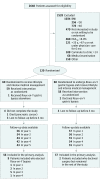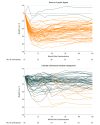Lifestyle Intervention and Medical Management With vs Without Roux-en-Y Gastric Bypass and Control of Hemoglobin A1c, LDL Cholesterol, and Systolic Blood Pressure at 5 Years in the Diabetes Surgery Study
- PMID: 29340678
- PMCID: PMC5833547
- DOI: 10.1001/jama.2017.20813
Lifestyle Intervention and Medical Management With vs Without Roux-en-Y Gastric Bypass and Control of Hemoglobin A1c, LDL Cholesterol, and Systolic Blood Pressure at 5 Years in the Diabetes Surgery Study
Abstract
Importance: The Roux-en-Y gastric bypass is effective in achieving established diabetes treatment targets, but durability is unknown.
Objective: To compare durability of Roux-en-Y gastric bypass added to intensive lifestyle and medical management in achieving diabetes control targets.
Design, setting, and participants: Observational follow-up of a randomized clinical trial at 4 sites in the United States and Taiwan, involving 120 participants who had a hemoglobin A1c (HbA1c) level of 8.0% or higher and a body mass index between 30.0 and 39.9 (enrolled between April 2008 and December 2011) were followed up for 5 years, ending in November 2016.
Interventions: Lifestyle-intensive medical management intervention based on the Diabetes Prevention Program and LookAHEAD trials for 2 years, with and without (60 participants each) Roux-en-Y gastric bypass surgery followed by observation to year 5.
Main outcomes and measures: The American Diabetes Association composite triple end point of hemoglobin A1c less than 7.0%, low-density lipoprotein cholesterol less than 100 mg/dL, and systolic blood pressure less than 130 mm Hg at 5 years.
Results: Of 120 participants who were initially randomized (mean age, 49 years [SD, 8 years], 72 women [60%]), 98 (82%) completed 5 years of follow-up. Baseline characteristics were similar between groups: mean (SD) body mass index 34.4 (3.2) for the lifestyle-medical management group and 34.9 (3.0) for the gastric bypass group and had hemoglobin A1c levels of 9.6% (1.2) and 9.6% (1.0), respectively. At 5 years, 13 participants (23%) in the gastric bypass group and 2 (4%) in the lifestyle-intensive medical management group had achieved the composite triple end point (difference, 19%; 95% CI, 4%-34%; P = .01). In the fifth year, 31 patients (55%) in the gastric bypass group vs 8 (14%) in the lifestyle-medical management group achieved an HbA1c level of less than 7.0% (difference, 41%; 95% CI, 19%-63%; P = .002). Gastric bypass had more serious adverse events than did the lifestyle-medical management intervention, 66 events vs 38 events, most frequently gastrointestinal events and surgical complications such as strictures, small bowel obstructions, and leaks. Gastric bypass had more parathyroid hormone elevation but no difference in B12 deficiency.
Conclusions and relevance: In extended follow-up of obese adults with type 2 diabetes randomized to adding gastric bypass compared with lifestyle and intensive medical management alone, there remained a significantly better composite triple end point in the surgical group at 5 years. However, because the effect size diminished over 5 years, further follow-up is needed to understand the durability of the improvement.
Trial registration: clinicaltrials.gov Identifier: NCT00641251.
Conflict of interest statement
Figures



Comment in
-
Reimagining Obesity in 2018: A JAMA Theme Issue on Obesity.JAMA. 2018 Jan 16;319(3):238-240. doi: 10.1001/jama.2017.21779. JAMA. 2018. PMID: 29340660 No abstract available.
-
Surgery: The new gold-standard - medical gastric bypass.Nat Rev Endocrinol. 2018 May;14(5):257-258. doi: 10.1038/nrendo.2018.28. Epub 2018 Mar 16. Nat Rev Endocrinol. 2018. PMID: 29546872 No abstract available.
References
-
- American Diabetes Association Standards of medical care in diabetes--2008. Diabetes Care. 2008;31(suppl 1):S12-S54. - PubMed
-
- Mingrone G, Panunzi S, De Gaetano A, et al. . Bariatric-metabolic surgery versus conventional medical treatment in obese patients with type 2 diabetes: 5 year follow-up of an open-label, single-centre, randomised controlled trial. Lancet. 2015;386(9997):964-973. - PubMed
Publication types
MeSH terms
Substances
Associated data
Grants and funding
LinkOut - more resources
Full Text Sources
Other Literature Sources
Medical
Research Materials
Miscellaneous

